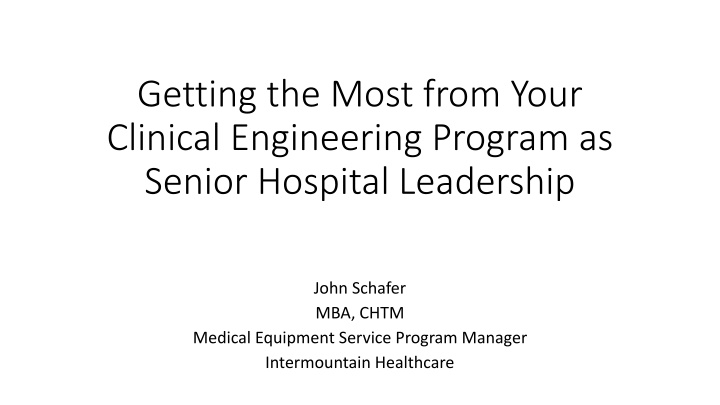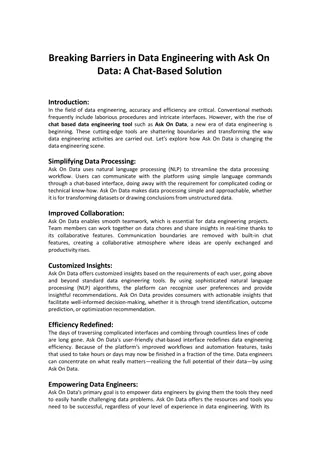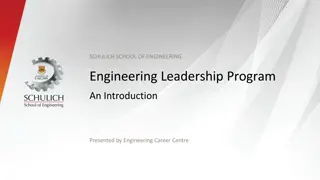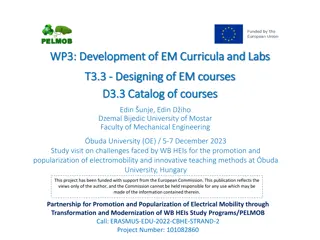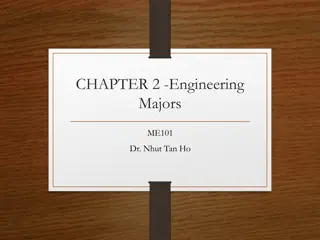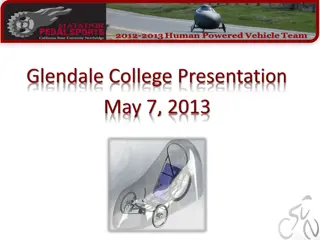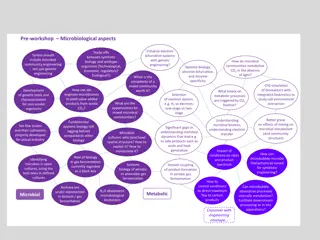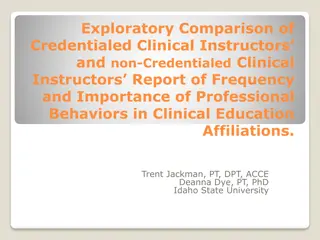Maximizing Your Clinical Engineering Program
Enhance the efficiency and effectiveness of your clinical engineering program with insights shared by John Schafer, MBA, CHTM. Learn about Intermountain Healthcare's integrated services and support structure to optimize your hospital's equipment management. Access a comprehensive toolbox for presenting this valuable information to your administration, and take proactive steps to streamline your processes and improve outcomes.
Download Presentation

Please find below an Image/Link to download the presentation.
The content on the website is provided AS IS for your information and personal use only. It may not be sold, licensed, or shared on other websites without obtaining consent from the author.If you encounter any issues during the download, it is possible that the publisher has removed the file from their server.
You are allowed to download the files provided on this website for personal or commercial use, subject to the condition that they are used lawfully. All files are the property of their respective owners.
The content on the website is provided AS IS for your information and personal use only. It may not be sold, licensed, or shared on other websites without obtaining consent from the author.
E N D
Presentation Transcript
Getting the Most from Your Clinical Engineering Program as Senior Hospital Leadership John Schafer MBA, CHTM Medical Equipment Service Program Manager Intermountain Healthcare
About Intermountain Healthcare About Intermountain Healthcare
An Integrated Delivery Network with a Tradition of Innovation About Intermountain Healthcare About Intermountain Healthcare Helping people live the healthiest lives possible Helping people live the healthiest lives possible TM 39,000 Employees $2 B Non-labor spend Based in Salt Lake City, Utah Continuum of Care TeleHealth Homecare Life Flight Central lab Central pharmacy Clinical Engineering Intalere Medical Group Health Plans Hospitals 1986 Started 2015 Ownership Commercial platform $8B Spend GPO 1983 Started SelectHealth 900,000 members 25% of Utah market 1994 Started 1,400 employed physicians 4,000 affiliated physicians 185+ clinics 1975 Beginning 22 Hospitals 2,800 Licensed Beds
CLINICAL ENGINEERING SUPPORT SERVICES STRUCTURE Central Support Services and Management System Director Compliance Manager Central Support Manager Service Coordination Center Office Coordinator Inventory Coordinator Data Analysts CE Regional and Hospital Operations Five Regional CE Directors Local CE Departments and Technicians Local Parts and Supply Stock Imaging Equipment Services Program Program Manager Regional Service Engineers Centralized Parts Stock Central Depot Repair Services Program Manager Depot Clinical Engineers Centralized Parts Stock
This is your tool box For all of you here, I am presenting the toolbox you will have available to present this to your own administration. Take this slide deck and change it however you want, and present it to your administration. Be proactive, and make your life easier!! John.Schafer@imail.org and I will send you your own copy
Getting the most from your Clinical Engineering department as Hospital Leadership
Old school Biomed A Break-Fix Clinical Engineering operation is your standard CE shop where the in-house staff repairs what they can, and the rest will be sent out or put under a service contract. The CE shop is not engaged for any other contribution to the hospital s operation, except for that odd once-in-a-while situation no one else knows what to do with.
Missing out How many of us have heard Just stay in your shop and pay attention to your job when we bring up a suggestion on how to do things better? I have both worked in and been in charge of shops like this, and I would say hospital leadership is missing out on a very rich source of information and an opportunity to enhance their hospital s operations.
Comprehensive program The other end of the spectrum is what I would call the comprehensive Clinical Engineering program. Clinical Engineering is actively involved with the medical equipment life cycle process, from equipment pre-sourcing, through the entire life cycle, and making the most of the equipment as it is retired.
Services available you already have but didnt know Many of the services available through your Clinical Engineering shop include: sourcing collaboration, equipment standardization, prevent your hospital from buying junk, installation planning, pre purchase clinical evaluation, and maximizing the warranty. In general these are all excellent ways to cut future expenses.
The Equipment Life Cycle Equipment Planning Technology Assessment and Selection Budgeting and Financing Procurement and logistics Installation and Commissioning Training and Skill Development Operation, Maintenance and Repair Decommissioning and Disposal
Pre-Purchase Planning Everyone who has had management training has heard the principle of 7 Ps: Previous Proper Planning Prevents p** s poor performance (That s the Navy version anyway). Many times departments are in a hurry to purchase medical equipment and do so without any planning because: We have money for that in the budget .
New Equipment Comparison by Total Cost of Ownership Clinical Engineering is an integral part of determining what the total cost of ownership will be for proposed new equipment acquisitions. What will be the cost of service (in- house vs. contract)? What will be the cost of consumables? What is the expected life span of your new acquisition? Can this be supported past the planned end of life date through using an alternate source for parts and service? The answers to all of these questions will help determine the correct path to maximize the return on investment (ROI) on these new purchases.
Pre-Purchase Planning Things you can miss out on during initial purchase include installation, service manuals, user manuals, software necessary to make everything work, test apparatus, CE tech training, will this be under a service contract or serviced in house, user application training, and technical support; all of which could be an additional cost if procured separately after the initial purchase. There is also the loss of establishing an economy of scale by treating each department as its own entity and discounting the entire hospital s medical equipment inventory as a fleet of equipment to be managed as a large unit.
Pre-Purchase Planning In fact a some facilities the lack of pre-purchase collaboration results in Clinical Engineering discovering new equipment when it shows up for delivery at the back dock. Do you already have some equipment that does the same function? Having multiple patient wings, all having different brands of monitoring is a great example.
Pre-Purchase Planning The nursing staff has to be trained for all different brands. There will be several types of consumables, and the ability to view all monitored patients from a single nursing station is going to be a challenge. Without pre-purchase planning, interoperability becomes very difficult or not even possible.. In addition, your hospital s operation will not be anywhere near as good as it could be; and you will most likely end up spending more money to boot.
Technology Assessment and Selection Buying more features than you need= spending more $ than you need to The more features a piece of medical equipment has- The more things there are to break. We may expand services so we should get the equipment to do those services. Is this actually taking place or is this wishful thinking?
Unnecessary features https://www.youtube.com/watch?v=Rx6WB5YJia8
Budgeting and Financing Ownership of medical equipment is not free. It will need to be repaired, upgraded, and don t forget consumables. For example, consider the Genius II thermometer. Last time I looked those little probe covers cost 2.8 cents each in bulk. Once you have applied some basic math you will see that taking one million temperatures will cost you $28,000! In a children s hospital or large inpatient facility it will not take long to accomplish that very thing.
Budgeting and Financing Since you probably can t always increase your top line revenue (you have already done that as much as you can), you can increase what s left over on the bottom line by cutting expenses that you will incur. There are numerous pieces of medical equipment that can be supported past the OEM end of life date. Never buy anything that is label End of model . It is not a bargain.
Budgeting and Financing Warranty maximization is a huge opportunity for cost savings. There are many warranty options available other than one year, parts and labor . Some other options will include training, parts, tech support and plastic components. At Intermountain Healthcare we recently changed the entire health system to the Carefusion 8000 series Brain and Channel style IV pumps. Rather than the standard one year warranty, we looked into other options to maximize our benefit. And besides, all you need to is ask what your options are. The worst thing an OEM can do is to say No.
Budgeting and Financing They will have information on what equipment has an end of life date. Can that equipment be supported past the end of life date due to the availability of alternate sources? What equipment is not going to make it to the end of its recommended service life and will need to be replaced early? If you are a hospital administrator or CFO and you need to replace 25-million dollars worth of equipment and you only have 18-million dollars to work with on a good day (does that sound familiar?), that type of information is worth its weight in gold
Budgeting and Financing Clinical Engineering can also provide a valuable service by reviewing service contacts to find instances on where you are paying more than you need to for service. Does that X-ray unit in your outpatient clinic that operates from 8am to 5pm really need a premium 24 x 7 service contract? No, it can be supported nicely by an 8-5, Monday through Friday contract for a much lower price. Or do you have contracts that could be eliminated all together by training your in-house CE staff? Contact me on LinkedIn, I can tell you all about it.
Procurement and Logistics Make sure you have included user/applications training, service manuals, operator s manuals, consumables, preferred pricing for future consumables, and explored all warranty options available. As the purchaser of new equipment or services, YOU have the power to dictate the conditions of the deal. If you would rather have OEM training for your in-house Clinical Engineering staff and 3 years of parts coverage instead of the standard one year warranty, bring it up. The WORST thing they can do is say NO!!
Procurement and Logistics Make sure that Everything you will possibly want is included in your final quote. Once the ink for the signature is dry, every item that you want to add is going to cost extra. SO MAKE SURE YOU HAVE EVERYTHING BEFORE YOU SIGN.
Procurement and Logistics Is this large enough to need a project manager? Will this unit have to be delivered before installation can be done? Will storage be required? Make sure the warranty doesn t start until the unit is actually installed.
Installation and Commissioning What will it take to get this unit installed? MRI will need to have a large hole in the building, etc. Do you need to have a lot of wires installed in the walls and interstitial spaces? How will this interface with the IT backbone? I guarantee the IT department will have something to say about it.
Operations To maintain an ongoing reduction of expenses, engage your Clinical Engineering department to operate as an equipment Life Cycle management program, rather than just fix what breaks. No one in the entire facility has the firsthand knowledge of the condition of the equipment and the ability to support it like the CE department does.
Operations They will have information on what equipment has an end of life date. Can that equipment be supported past the end of life date due to the availability of alternate sources? What equipment is not going to make it to the end of its recommended service life and will need to be replaced early? Did you know that tocotransducers can be repaired instead of just thrown away? They can be repaired at great savings. Many peripheral devices can be repaired.
Operations If you are a hospital administrator or CFO and you need to replace 25-million dollars worth of equipment and you only have 18-million dollars to work with (does that sound familiar), that type of information is worth its weight in gold
Training and Skill Development When you have new equipment being installed- Operator training is essential Clinical Engineering will need training on the more complex systems if this will be serviced in-house
Maintenance and Repair Does this model have an end of life date already established? Does this model have a large third party service base?
Decommissioning and Disposal Repurposing equipment- Can this equipment be reutilized in another department with a less critical need? Old vital signs monitors can be reused in non-critical settings, old telemetry can go to cardiac rehab, etc. This is also a very effective tool in a multi-facility system. Is this equipment beyond economical repair? If yes avoid it like the plague!! Pulling old equipment that needs repair off of the scrap pile will probably cost you more than purchasing a used or refurbished unit.
Decommissioning and Disposal Your Clinical Engineering department can assist with equipment sales to maximize your equipment sales revenue. We are bombarded by companies that want to buy used medical equipment and we can pass that information along. Used equipment that is in operational condition is worth more money upon resale. Your CE department can work with OEMs and other suppliers to make sure hard drives are purged of patient data but still have the operating systems in place
Conclusion I really see this, not as a trend, but as the future of Clinical Engineering in healthcare as a way to gain out- of-the-box savings. In order to provide the highest quality and most affordable health care possible, we must engage internal resources in new ways where they can add value, cut costs and improve service.
Conclusion In my career, I have had discussions with more than one hospital administrator or CFO that a flat top line with an increased bottom line due to cost cutting is not exactly how I had envisioned the year, but I love the result. The only problem with this is it is almost always immediately followed by What else you got ?
Conclusion Talk to your Clinical Engineering Department. I guarantee you they will be interested in working with whoever will be buying equipment. After all, it is in their best interest on helping make the best deal: they will be supporting it for the next 8 to 10 years or more. Working with you on pre-purchase planning is how they can make their own lives easier.
Conclusion As administrators, you are looking for ways to do it better with less money and resources. The good news I have for you is these resources are already in the building. Your Clinical Engineering department would most likely jump at the chance to work with other departments to structure the best purchase deals on new equipment as it will make their life a lot easier when it is time to service that new equipment. Ask them when you are out practicing management by walking around . You will be surprised what resources are already available to you.
